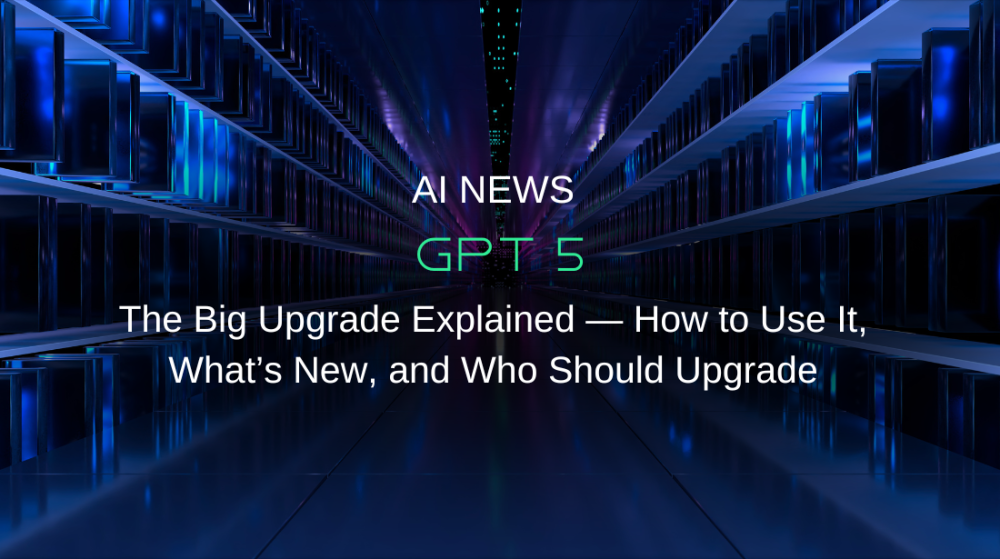OpenAI GPT-5: The Big Upgrade Explained — How to Use It, What’s New, and Who Should Upgrade
If you’ve ever wanted your AI to know the difference between "just gimme the quick answer” and "please put on your thinking cap,” OpenAI’s GPT-5 is your new favorite coworker. It’s now the default model in ChatGPT, it’s faster on easy stuff, more methodical on hard stuff, and much less likely to butter you up with empty flattery. In short: fewer vibes, more brains.
What launched and why it matters
OpenAI describes GPT-5 as a unified system backed by a real-time router. Most queries go to a fast, efficient model; harder ones get escalated to "GPT-5 Thinking,” the deeper reasoning path. If you type "think hard about this,” it obliges. Hit your usage limits? A smaller GPT-5 mini steps in so you’re not left hanging.
Why you should care:
- Meaningful gains in writing, coding, and health
- Fewer hallucinations and less sycophancy (it won’t just agree with you)
- Stronger multimodal performance on images, charts, and video
How GPT-5 "thinks” without wasting your time
Think of the router as air traffic control for your prompt. Simple question? Quick runway, fast answer. Complex, high-stakes, or tool-heavy task? It routes to deeper reasoning. The router learns from real signals (model switches, preferences, correctness) and gets smarter over time. You can override it by picking "GPT-5 Thinking” or literally typing "think hard about this.”
Router highlights:
- Auto-detects complexity and tool needs
- Honors explicit intent in your prompt
- Falls back to GPT-5 mini after usage limits
- Long-term plan: merge into a single, unified model
GPT-5 Router Flight Deck
Controls
Request GPT‑5 Thinking explicitly.
Browsing/data/code tools required.
Fallback to GPT‑5 mini so you’re not blocked.
What the router did
Real-world upgrades
Writing
- Better structure, rhythm, and tone control
- Stronger at ambiguous forms (free verse, unrhymed meter)
- Everyday help: crisper emails, memos, reports
Coding
- Best OpenAI coding model yet
- Improved complex front-end generation and large-repo debugging
- Notably better layout choices: spacing, typography, white space
Health
- Scores higher on realistic scenarios (not a medical professional)
- Asks clarifying questions, adapts to context and geography
- Safer, more precise guidance to prep for real appointments
Benchmarks (and what they actually mean)
A few headline scores (per OpenAI):
- Math: AIME 2025 (no tools) — 94.6%
- Coding: SWE-bench Verified — 74.9%; Aider Polyglot — 88%
- Multimodal: MMMU — 84.2%
- Health: HealthBench Hard — 46.2%
- Science: GPQA Diamond (GPT-5 Pro, no tools) — 88.4%
Translation:
- Fewer wrong turns on hard logic problems
- Better at fixing real software issues and editing multilingual code
- More accurate with images, charts, slides, and video
- Stronger, contextual health explanations (still not a doctor)
Speed without the verbosity tax
GPT-5’s "thinking” mode matches or beats o3 on tough tasks using roughly 50–80% fewer output tokens. That means:
- Faster reads
- Lower token spend for power users
- Less fluff, more signal
Trained on Microsoft Azure AI supercomputers. Translation: serious horsepower.
Safety, honesty, and fewer "confidently wrong” moments
Instead of only refusing risky prompts, GPT-5 leans on "safe completions”—answer helpfully within guardrails and clearly explain limits when it must stop.
Notable shifts:
- ~45% fewer factual errors than GPT-4o on anonymized web-search prompts
- ~6x fewer long-form hallucinations than o3 in reasoning mode
- Deception rate down to 2.1% (from o3’s 4.8%) on production-style tasks
- Reduced sycophancy by more than half
- Bio/chem: treated as high capability with multilayer safeguards and extensive red-teaming
Customization and developer tools
Preset personalities (text first, voice later):
- Cynic
- Robot
- Listener
- Nerd
Developer perks:
- Build with GPT-5 via the Codex CLI (sign in with ChatGPT)
- GPT-5 Pro for extended reasoning on the hardest problems
Availability: who gets GPT-5 and when
Rollout snapshot:
- Default in ChatGPT for signed-in users (replaces GPT-4o, o3, o4-mini, 4.1, 4.5)
- Free: access with lower limits; falls back to GPT-5 mini after cap
- Plus: higher usage for everyday work
- Pro: unlimited GPT-5 and access to GPT-5 Pro
- Team: rolling out now
- Enterprise and Edu: about a week behind
How to try it:
- Open ChatGPT and ask your question, routing is automatic
- Want deep reasoning? Select "GPT-5 Thinking” or say "think hard about this”
- Developers: sign in and use the Codex CLI
The big picture
GPT-5 feels like a step from "smart autocomplete” to "adaptable partner.” It writes with rhythm, codes with taste, reads charts without panicking, and, when asked thinks deeply without drowning you in words. If the router keeps learning and the safety work holds up, expect this model to quietly slip into your workflows and just… get more done. No, it still won’t fold your laundry, but it can design a slick app to guilt-trip you into doing it.





